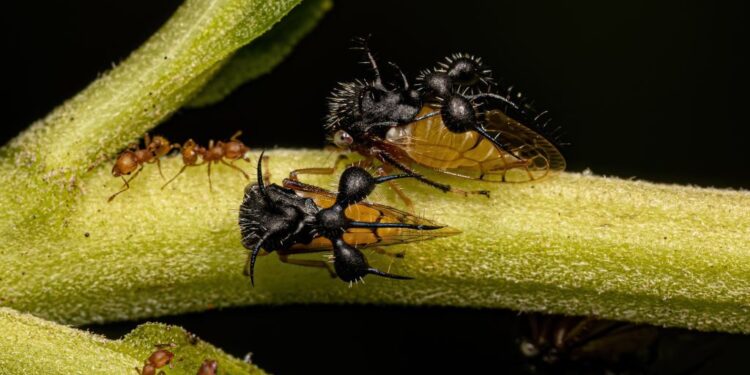The Brazilian treehopper, also known as Bocydium globulare, is a small insect that belongs to the family Membracidae. It is found in the Amazon rainforest and other tropical regions of South America. This insect has a unique appearance and behavior that have captured the attention of scientists and nature enthusiasts alike.
Physical Characteristics
The Brazilian treehopper is a small insect that measures about 1 cm in length. Its body is shaped like a dome, with a distinctive bulge on its back. This bulge gives it the appearance of a tiny helmet or saddle. The color of this insect varies from brown to green or yellow, depending on its habitat.
One of the most interesting features of the Brazilian treehopper’s appearance is its ability to change colors. Scientists believe that this ability may be used for camouflage or communication purposes.
Another notable physical characteristic of this insect is its sharp mouthparts, which it uses to pierce through the bark of trees and extract sap from their tissues.
Behavior
One of the most fascinating aspects of the Brazilian treehopper is its behavior. This insect has a specialized structure on its back that allows it to produce vibrations and sounds. These vibrations are used as a means of communication between individuals, especially during mating season.
In addition to producing sounds, these insects also engage in visual displays as part of their courtship behavior. Male treehoppers will perform elaborate dances and movements to attract females.
Another interesting behavior exhibited by these insects is their tendency to group together in large numbers. They form clusters on branches and leaves, which can be seen from afar due to their distinctive shape and color.
Habitat
The Brazilian treehopper is native to the Amazon rainforest, but it can also be found in other tropical regions of South America. These insects prefer humid environments and are often found near rivers or streams.
Despite their preference for humid habitats, these insects are adaptable and can survive in drier areas as well. They are able to regulate their body temperature through behavioral adaptations such as basking in sunlight or seeking shade under leaves.
Diet
Like many insects, the Brazilian treehopper feeds on plant sap. It uses its sharp mouthparts to pierce through the bark of trees and extract sap from their tissues. Despite being relatively harmless to plants, these insects can cause damage when present in large numbers.
In addition to feeding on plant sap, some species of treehoppers have been known to consume other insects as well. However, this behavior seems to be rare among Brazilian treehoppers specifically.
Threats
Although not considered endangered at this time, the Brazilian treehopper faces threats from deforestation and habitat loss. As more areas of the Amazon rainforest are cleared for agriculture and urbanization, these insects may lose their natural habitats and become more vulnerable to predation.
Furthermore, because they are such small organisms with limited mobility outside their habitats; they remain highly susceptible if exposed even briefly outside forest edges due mainly due predators like birds who feed on them extensively.
Reproduction
Reproduction among Brazilian treehoppers typically occurs during the rainy season when food resources are abundant. Males use vocalizations and visual displays such as dancing movements (as mentioned before) in order attract females for mating purposes.
After mating occurs; female tree hoppers lay eggs by inserting them into plant tissue using an ovipositor located at her abdomen’s end.
Most species’ eggs hatch within two weeks after deposition; with hatchlings resembling miniature versions adult forms.
Juvenile nymphs undergo several molts throughout development until they reach adulthood status similar size-wise but lack reproductive organs until reaching sexual maturity around six months later.
Threats
Although not considered endangered at this time; there has been concern over populations declining due mainly deforestation across Brazil’s biomes resulting from agricultural expansionary practices including soybean cultivation which poses significant threats towards all ecosystems globally if left unchecked!
Furthermore; due primarily due predators like birds who feed extensively upon them; any exposure outside forest edges remains highly susceptible without proper conservation efforts put forward towards preserving essential habitats needed for survival.
Conservation Efforts
Efforts towards conservation initiatives have been aimed at protecting vital habitats such as reforestation projects & protected reserves throughout Brazil’s diverse biomes where these incredible creatures thrive best!
By conserving natural resources through sustainable agriculture practices like agroforestry techniques & reducing deforestation rates while promoting eco-tourism opportunities within Amazonian forests; we can help ensure long-term survival success stories for biodiversity conservation efforts underway today!
Here are some interesting facts about this tiny creature:
1. Unique Appearance
The Brazilian treehopper has a distinctive appearance that sets it apart from other insects. It has a round body with spines protruding from its exoskeleton, giving it the appearance of a miniature porcupine.
2. Vibrant Colors
Despite its small size, the Brazilian treehopper is brightly colored with vibrant hues of red, yellow, and green. These colors serve as camouflage in their natural habitat, helping them blend in with their surroundings.
3. Unusual Behavior
One of the most interesting aspects of the Brazilian treehopper is its unusual behavior. When threatened by predators or disturbance, they will start to vibrate rapidly and jump up and down on their plant host to create an intimidating display.
4. Important Ecological Role
Although small in size, the Brazilian treehopper plays an important ecological role in the rainforest ecosystem. They feed on sap from plants which helps to regulate plant growth and nutrient cycling.
5. Cultural Significance
The Brazilian treehopper has also played a significant cultural role in indigenous Amazonian communities who have used its spines for decorative purposes for centuries.
Overall, the Brazilian treehopper is a unique and fascinating insect with distinct physical features and behaviors that make it stand out among other insects in its natural habitat.
Conclusion
In conclusion, the Brazilian treehopper is a unique and fascinating insect that has captured our attention with its distinctive appearance and behavior. As we continue to explore the wonders of nature, it’s important to remember that all species play an important role in maintaining ecological balance.
By protecting these insects’ habitats through conservation efforts such as reforestation initiatives or protected reserves; we can ensure their survival for generations while preserving biodiversity across ecosystems throughout Brazil’s diverse biomes!






